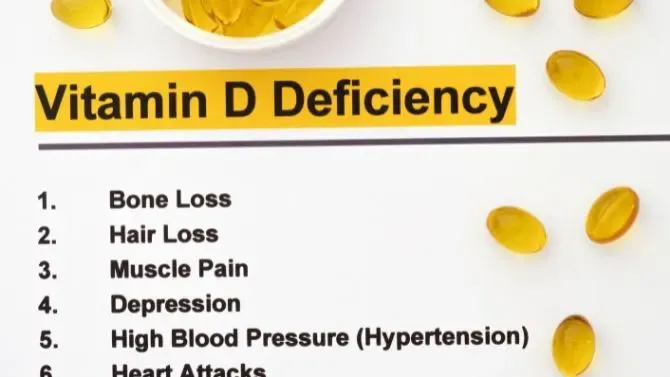Vitamin D

What is Vitamin D?

The synthesis of vitamin D is stimulated by the exposure of our skin to ultraviolet solar rays, in particular UVB. Minimal exposure to the sun is therefore necessary for the body to produce it.
Vitamin D has an action on several functions of the body:
- It intervenes in the absorption of calcium and phosphorus at the intestines level. It ensures the mineralization of bones, joints thus influencing bone growth. Identified in 1922 by Elmer McCollum as part of the care provided against rickets (disease-causing retardation of bone growth due to a vitamin D deficiency ), it has made it possible to fight this disease effectively.
- It limits bone fractures, ensuring the strength of bones and teeth.
- It limits the appearance of osteoporosis in the elderly. This disease causes a decrease in bone density, which weakens the body's bones.
- It strengthens muscle tone by promoting the renewal of muscle fibers and muscle contraction during movement.
- It provides a protective function of neuronal cells and delays cognitive decline.
- It would also ensure protective effects against cardiovascular diseases, diabetes and certain cancers. However, these latter functions have not been formally proven.
The benefits of vitamin D
The benefits of vitamin D stem from its role in the body. Essential for ensuring bone growth and health, vitamin D helps regulate blood calcium levels and phosphorus absorption. If the body were to lack vitamin D, the calcium would be eliminated in the urine by the kidneys.Therefore, it makes it possible to capture calcium and "fix" it on the bones to ensure their maturation.
Therefore, it is essential not to neglect food intake to benefit from vitamin D and to regularly check the blood level of this vitamin in the body.
Studies are currently underway to demonstrate the beneficial effects of vitamin D on reducing the progression of certain cancerous diseases (especially colon cancer), limiting the onset of multiple sclerosis Alzheimer's disease, and reducing several cardiovascular disorders and seasonal depression.
Note: Exposure to the sun for about 15 to 30 minutes, twice a week, ensures sufficient vitamin D intake in an adult. We do not hesitate to expose ourselves to the sun when we have the opportunity to promote the synthesis of vitamin D. We do not forget to protect our skin by applying a suitable sunscreen to do this.
Deficiency symptoms vitamin D
It is interesting to highlight the symptoms that can alert you to a possible deficiency to benefit from vitamin D supplementation. It would help if you reacted when you noticed the following signs:- Muscle pain, bone pain
- Joint pain
- Back pain
- chronic fatigue
- Temporary depression
- Being sick often or getting infections more often
- Impaired healing
- Frequent falls (especially in the elderly)
Recommended nutritional allowances

The nutritional references or recommended intakes of vitamin D are expressed in micrograms (µg) or international units (IU). They correspond to:
- Newborns/babies up to 12 months: 20/25µg or 800/1000 IU per day
- Children aged 1 to 3 years: 10 µg/day, i.e., 400 IU/day
- Children aged over 36 months, adolescents from 12 to 18 years old and adults: 15 µg/day, i.e., 200 IU/day
- Children aged 1 to 3 years: 10 µg/day, i.e., 400 IU/day
- Children aged over 36 months, adolescents from 12 to 18 years old and adults: 15 µg/day, i.e., 200 IU/day
- Over 75 years old: 10 to 15 µg/day, i.e., 400/600 IU/day
Pregnant or breastfeeding women should be careful with their vitamin D intake. Indeed, some scientists believe that vitamin D helps prevent pre-eclampsia and gestational diabetes.
Top 5 Foods That Contain Vitamin D

Vitamin D is present in a few foods, and however, it is possible to add products rich in vitamin D to your diet. Especially in winter, when sunny days are rarer, our exposure is reduced.
1. Cod liver oil
Cod liver oil brings back bad memories to our elders. Their grandmothers gave a teaspoon of cod liver oil to their children to ensure their good health. And they weren't necessarily wrong!Cod liver oil is very rich in vitamin D. It contains 250 µg per 100g. A teaspoon provides 37.5 µg of vitamin D, three times the recommended daily allowance! You might as well add it to the menu to avoid deficiencies. Cod liver contains 100 µg of vitamin D per 100 g.
2. Oily fish
Oily fish have many virtues and are excellent for your health. They contain omega 3, good for the brain, sleep or limit stress, and vitamin D.Do not hesitate to add sardines, tuna, mackerel or salmon to your menus to benefit from their benefits.
To avoid composing dishes that are too rich in fat, it is preferable to eat this type of fish grilled, baked or en papillote, accompanied by vegetables and starchy foods.
3. Eggs
Eggs, rich in protein, are beneficial for the brain. They also contain vitamin D (0.94 µg/egg).Eggs are ideal for evening meals. To eat hard, in salad or omelet, precisely a soup, green vegetables, or a green salad.
4. Milk and dairy products
Milk, butter, yogurt, and cottage cheese contain vitamin D. Some dairy products are fortified with vitamin D and marketed for their growth and bone strength benefits. It is a marketing argument, indeed, but proven.Dairy products efficiently complete your daily menus to be consumed at breakfast, lunch or dinner for dessert or a snack (a glass of hot milk before bedtime).
5. Mushrooms
Mushrooms, especially chanterelles, morels or shiitake mushrooms (Japanese mushrooms), are also a source of vitamin D. The advantage of these foods is that they are low in calories. It can be consumed in large quantities.Cooking the mushrooms in a frying pan, in a vegetable oil rich in omega 3, makes it possible to compose succulent accompaniments for your meat and fish. They can be eaten with a portion of starches to craft nutritious and healthy meals.
Dangers and side effects, vitamin D overdose
We now know the effects of vitamin D deficiency. What happens when vitamin D intake is too high? What are the risks of overdose?Vitamin D overdoses have become rare, as intakes are better controlled.
These stones can cause significant pain and cause complications such as renal colic. Calcium deposition in the kidneys is called nephrocalcinosis, a kidney disease that can also result from vitamin D overdose.
Hypercalcemia appears when a subject is exposed to doses greater than 40,000 IU/day. Symptoms of vitamin D overdose are:
- Nausea or vomiting
- Asthenia (fatigue)/drowsiness
- Headaches (headaches)
- Dehydration/great thirst
- Muscle weakness and pain
- Anorexia
- Increased blood nitrogen level (azotemia)
Read More\
Post a Comment